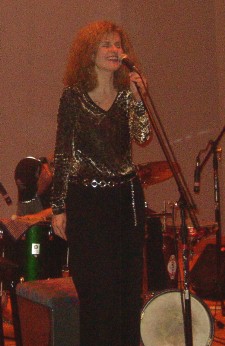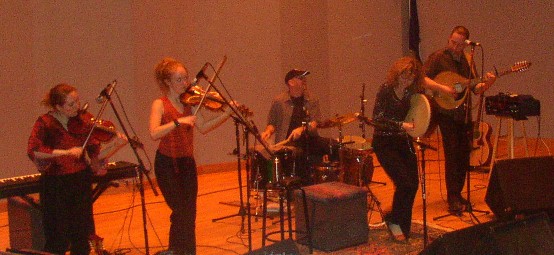It’s that time of year when everyone claims to be Irish, time for the wearing of the green, the drinking of the green beer; a time for shamrocks, leprechauns, lousy versions of “Londonderry Air,” and lots of Celtic music.
I asked Irish-American singer Cathie Ryan, “What makes Celtic music Celtic?”
“A brilliant question,” she replied. “There is something that I can’t articulate about it that hits me, that calls up the whole image of the landscape of Ireland that I think is so beautiful and so feminine. It’s in the air of the song, it’s in the lyric---the lyric usually goes right to the heart, past the intellect and right to the heart.
“The instrumentation of course---tin whistles and fiddles, all of those instruments that have real human sounding voices. But there is a more elusive thing that’s kind of mysterious, like the land of Ireland. You get off a plane and you look up and there’s something that gives you a feeling. Irish music gives me that feeling too. I’m almost glad that I can’t explain it because it makes it larger.”
 In the world of contemporary Irish music, Cathie Ryan is about as large as you can get. The daughter of first generation Irish immigrants, she’s been building a following on the Irish/Celtic/folk scene for nearly twenty years. Friday night, she brings her band to the Virginia Beach Central Library for a return engagement under the auspices of the Tidewater Friends of Folk Music. It’s an appropriate way to celebrate the Day after St. Patrick’s Day.
In the world of contemporary Irish music, Cathie Ryan is about as large as you can get. The daughter of first generation Irish immigrants, she’s been building a following on the Irish/Celtic/folk scene for nearly twenty years. Friday night, she brings her band to the Virginia Beach Central Library for a return engagement under the auspices of the Tidewater Friends of Folk Music. It’s an appropriate way to celebrate the Day after St. Patrick’s Day.
Her parents moved from the British Isles to Detroit at the invitation of an aunt who advised, “There are three major motor companies and they’re always looking for work.” Her dad worked on the General Motors assembly line, and Cathie grew up during the heyday of Motown in that label’s hometown. She loved those soulful sounds, but she found herself drawn to the music of her parents’ native land.
“I think there are a couple of reasons,” she explained. “I think because it is very simply songs about the heart, songs about how you feel, songs about how we relate to each other. They are really songs of the people. They are about folk.
“For me as a kid growing up in Detroit, going to Ireland was such a gift. I mean, going from an urban environment where there was a lot of strife at the time, to this bucolic, mysterious landscape…and also seeing my grandparents on both sides. We had very little family in America, and suddenly there were cousins and aunts and uncles. You know, going out in the morning and milking the cows and sitting around the fire at night telling stories and singing songs. Neither of my grandparents had televisions, so it was really about what you gave to the group at night. My mother’s father was a storyteller, so he just told stories all night. And there was no light, no electricity in their house. He’d light a gas lamp and it was magical.
“Then in my father’s mother’s house, she would play the fiddle next to the fire. People would come in, she’d move the furniture so everybody could dance. It was what you could bring from yourself to entertain, to be entertained. There was so much more of a connection to each other because of that. You weren’t sitting around focused on a television set in your own mind, you were sharing things. You also had to contribute.
“I think that’s why Ireland was such a magical place. It was also a safe place.”
She left Detroit when she was seventeen to go to Fordham University in New York. She sang in a band, married a musician, became a mother, put her own music on the back burner, got divorced:
“When my son was little, I cleaned houses so I’d be there to take him to school and there when he got home. And then I went to college at night. I was really a nut.”
In 1987, she became the lead vocalist for Cherish the Ladies, an Irish traditional women’s ensemble.
“It was good to get my feet wet in a band of that size,” she said, “because the whole show wasn’t about me. It was spread across ten shoulders. There were five musicians, a singer and four dancers---in a bus on the road!”
After seven years with Cherish, Cathie Ryan struck out on her own. Her three subsequent solo albums reveal an artist of impressive depth, an individualistic songwriter as influenced by James Taylor as she is by the myths of Ireland. If this were the early ‘70s, she might be getting notice and FM airplay alongside JT, Joni Mitchell and Van Morrison. But she also remains a superb interpreter of songs from the Emerald Isle.
“Back in the early years when I first started,” she remembered, “before I had an audience that would come out specifically to see me and knew what I was doing, they would come and ask for ‘Danny Boy’ and ‘Tura Lura Lural’ and ‘When Irish Eyes are Smiling.’ It used to make me so angry, and then I realized there was no place for me to be angry about it. We were all in the process of educating the world about Irish music. A lot of people didn’t know there was music beyond the sort of pub songs of Ireland. So I feel really lucky that people want to come out and hear what I choose to sing. It’s a privilege.
“When I’m on a long road trip, I always have James Taylor there with me and I sing along. I do harmony and I’m glad no one can hear me. There’s a song on this new CD, the title track called ‘The Farthest Wave,’ and when I was singing it, all I kept thinking was, gosh, it would be so nice if James Taylor were singing this too. Because I’m sure he inspired it, just from all of my listening to him.”
Cathie Ryan’s last CD, Somewhere Along the Road, is an extraordinary recording, steeped in a Celtic sheen but accessible even to those who think they don’t like Irish music. It is a powerful musical statement. The Farthest Wave is set for release next month.
Friday night she’ll be here with her five-piece band of multi-talented multi-instrumentalists. It’s a show not to be missed, one of the best acoustic assemblages you’re likely to hear this year. And you don’t have to be Irish!
“It’s a primal music,” she said, “it’s a music that I think has always been there. It has to be on a very primitive level, in the spirit or the psyche, that this is the music of the people and it’s in all of us. I’ve had loads of people coming up to me and saying, ‘I have no Irish in me, but I am so pulled to this music.’”
Chances are you will be too.

copyright © 2005 Jim Newsom. All Rights Reserved.

